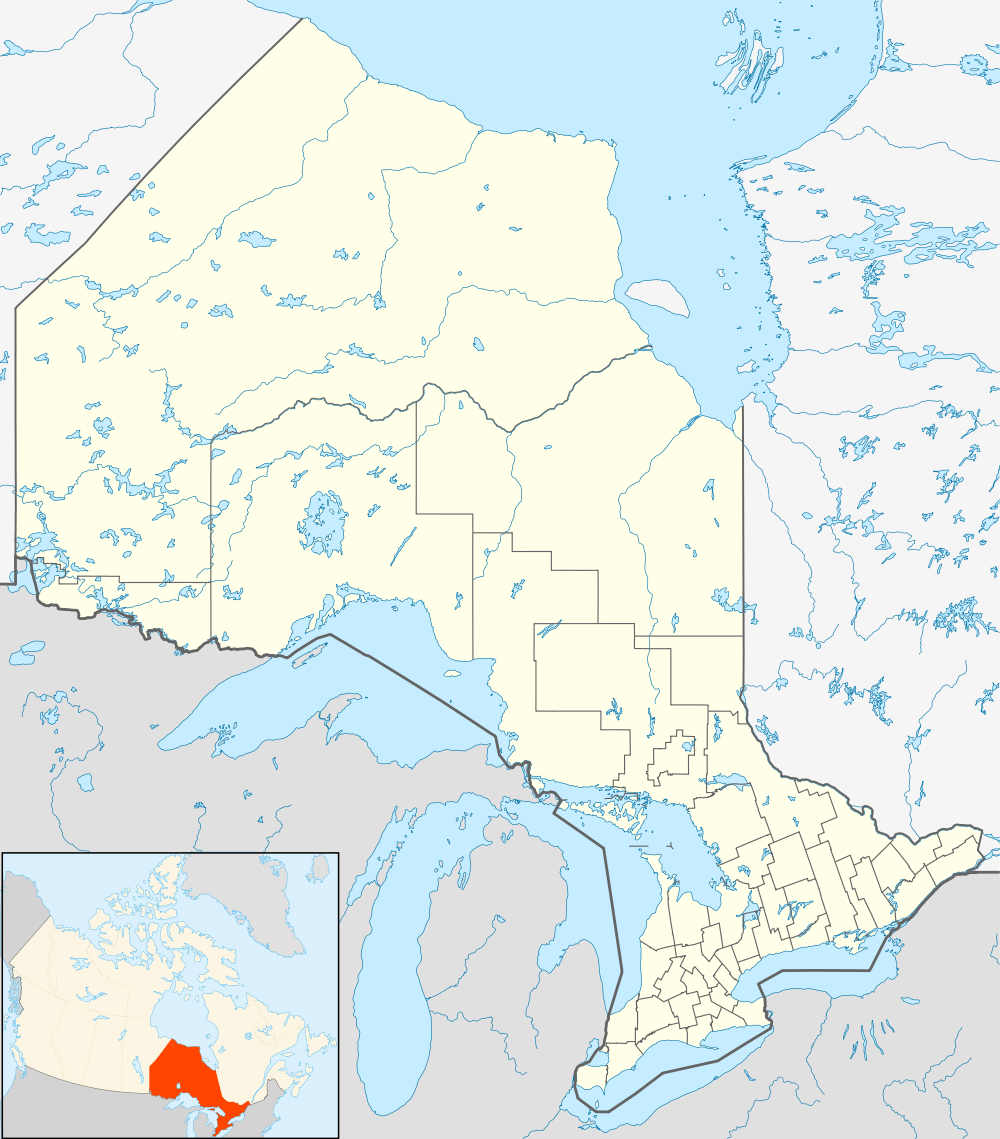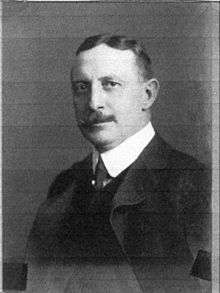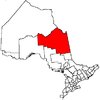Iroquois Falls
| Iroquois Falls | |
|---|---|
| Town (single-tier) | |
| Town of Iroquois Falls | |
|
Iroquois Falls municipal office | |
 Iroquois Falls | |
| Coordinates: 48°46′N 80°40′W / 48.767°N 80.667°WCoordinates: 48°46′N 80°40′W / 48.767°N 80.667°W | |
| Country |
|
| Province |
|
| District | Cochrane |
| Established | 1912 |
| Incorporated | 1915 |
| Government | |
| • Type | Town |
| • Mayor | Michael Shea |
| • MP | Charlie Angus (NDP) |
| • MPP | John Vanthof (NDP) |
| Area[1] | |
| • Land | 599.92 km2 (231.63 sq mi) |
| Elevation[2] | 259.1 m (850.1 ft) |
| Population (2011)[1] | |
| • Total | 4,595 |
| • Density | 7.7/km2 (20/sq mi) |
| Time zone | EST (UTC-5) |
| • Summer (DST) | EDT (UTC-4) |
| Postal code FSA | P0K |
| Area code(s) | 705 |
| Website | www.iroquoisfalls.com |
Iroquois Falls is a town in Northern Ontario, Canada, with a population of 4,595 at the 2011 census.[1]
The town centre lies 11 km east of Hwy 11 on the banks of the Abitibi River, west of Lake Abitibi. Timmins, one of the largest cities in northern Ontario, is approximately 70 kilometres (43 mi) to the southwest. The following communities are also within the municipal boundaries: Monteith, Nellie Lake, and Porquis Junction.
Iroquois Falls' primary industry was a large mill producing newsprint and commercial printing papers. In December 2014, the owner, Resolute Forest Products, announced its permanent closure.[3][4] There are also three hydro-electric dams nearby. The Monteith Correctional Complex, a provincial prison serving a regional catchment area, is located in the community of Monteith (named for Samuel Nelson Monteith).
History
The background of the town's name varies depending on the source, attributing it to invasions by the Iroquois on Huron or Ojibway villages. It is also unclear who has relayed the tale, settlers or the First Nations people themselves.[5]



.jpg)
.jpg)

Iroquois Falls was built as a company town by Frank Harris Anson, owner of the Abitibi Power and Paper Company. Anson had been influenced by the garden city movement of urban planning, and was committed to building an elaborate town. A Chicago architectural firm was hired to design the landscaping and houses, and work crews began clearing land in 1913. The town's park and commercial developments were clearly separated from the paper mill, and the residential streets curved with a focus on the center of the town. A large church was built, the first English Catholic Parish in Northern Ontario, and today remains a historic landmark. Anson's company town had a hospital, a school, and a company hotel. Employee homes were designed with gambrel roofs to resemble New England farmhouses, and their design and location reflected the employee's rank at the mill. Papermakers lived in double-adjoined homes, while senior managers lived on separate streets in single-family homes.[6]
Much of the town was destroyed by fire in 1916, though Anson continued his beautification program during the 1920s as the community rebuilt.[7]
The town's avant-garde style earned it the nickname "Anson's Folly".[6]
The town was incorporated in 1915, and a board of trade was chartered in 1926.
The paper mill created a dramatic change to the area, and people migrated to the community for work.
The creation of the Temiskaming and Northern Ontario Railway (now Ontario Northland Railway) greatly boosted the economy as there were few roads at the time.
As Iroquois Falls grew, two new communities within the town began to emerge. An area known first as "The Wye" (because the rail tracks split at this point) grew to the south, and was at first a ramshackle collection of cabins and shacks. It later became known as Ansonville, and was home to a number of business people and others who were shut out from the company town. In contrast to Iroquois Falls, Ansonville had little town planning, and no water, sewer, or electrical service. Insurance companies would not insure homes there because the risk of fire was too great, and the first residents were French-Canadians, Russians and Ukrainians. Animosity was frequent between Ansonville and Iroquois Falls, and many residents of Iroquois Falls condemned Ansonville "as a dark den of foreigners engaged in regular street brawls, illegal alcohol consumption, and other unsavoury activities"[6]:85
In 1921, Ansonville began to levy taxes, which led a group of residents to establish a third community named Victoria in the north-west section of the town. The name was later changed to Montrock.[6]
In 1979, the three communities were amalgamated into one town named Iroquois Falls.
The paper mill, then called Abitibi-Price, merged with Stone-Consolidated, and then with Donohue Forest Products, and finally with Bowater to create Abitbi-Bowater. On 17 April 2009, Abitibi-Bowater sought bankruptcy protection, emerging from it as Resolute Forest Products.
A tragic event occurred in 1984 at the coffee shop at Joe's Texaco in nearby Porquois Junction. Ontario Provincial Police constable Vern Miller was drinking coffee with his partner constable Norm Tiegen, when 23-year-old Gregg Prevost of Iroquois Falls entered and shot Miller with a shotgun, killing him instantly. The community was shocked and outraged, and Provost was sentenced to life in prison. The town of Matheson renamed their local arena the Vern Miller Memorial Arena in his honour.[8]
Geography
Climate
Iroquois Falls falls within the northern periphery of the Humid continental climate (Dfb) despite extreme January and February record lows that exceed that of many subarctic regions. In January 1935, the town set the record low temperature for Ontario of −58.3 °C (−73 °F), the town also happens to hold the unofficial February record low of −55.6 °C (−68 °F).[2] set in February 1899 (before the town was officially incorporated but weather was taken) and tied in February 1934 but it wasn't recorded at the location used for official temperature readings. Winter typically lasts from November through April.
| Climate data for Iroquois Falls | |||||||||||||
|---|---|---|---|---|---|---|---|---|---|---|---|---|---|
| Month | Jan | Feb | Mar | Apr | May | Jun | Jul | Aug | Sep | Oct | Nov | Dec | Year |
| Record high °C (°F) | 8.3 (46.9) |
10.0 (50) |
21.7 (71.1) |
31.7 (89.1) |
35.0 (95) |
38.0 (100.4) |
41.1 (106) |
37.2 (99) |
33.3 (91.9) |
28.9 (84) |
19.4 (66.9) |
14.5 (58.1) |
41.1 (106) |
| Average high °C (°F) | −11.0 (12.2) |
−8.2 (17.2) |
−1.3 (29.7) |
7.6 (45.7) |
16.1 (61) |
21.8 (71.2) |
24.1 (75.4) |
22.4 (72.3) |
15.8 (60.4) |
8.6 (47.5) |
0.1 (32.2) |
−7.8 (18) |
7.4 (45.3) |
| Daily mean °C (°F) | −17.9 (−0.2) |
−15.6 (3.9) |
−8.6 (16.5) |
0.9 (33.6) |
9.1 (48.4) |
14.5 (58.1) |
17.2 (63) |
15.8 (60.4) |
10.0 (50) |
3.9 (39) |
−4.2 (24.4) |
−13.8 (7.2) |
0.9 (33.6) |
| Average low °C (°F) | −24.7 (−12.5) |
−23.0 (−9.4) |
−15.9 (3.4) |
−5.9 (21.4) |
2.0 (35.6) |
7.3 (45.1) |
10.2 (50.4) |
9.1 (48.4) |
4.2 (39.6) |
−0.8 (30.6) |
−8.6 (16.5) |
−19.8 (−3.6) |
−5.5 (22.1) |
| Record low °C (°F) | −58.3 (−72.9) |
−45.6 (−50.1) |
−42.2 (−44) |
−30.0 (−22) |
−13.3 (8.1) |
−9.4 (15.1) |
−3.0 (26.6) |
−3.3 (26.1) |
−8.3 (17.1) |
−16.1 (3) |
−32.8 (−27) |
−46.1 (−51) |
−58.3 (−72.9) |
| Average precipitation mm (inches) | 49.4 (1.945) |
30.6 (1.205) |
49.7 (1.957) |
45.1 (1.776) |
60.9 (2.398) |
81.5 (3.209) |
93.3 (3.673) |
85.9 (3.382) |
96.6 (3.803) |
68.5 (2.697) |
57.2 (2.252) |
57.4 (2.26) |
776.0 (30.551) |
| Average rainfall mm (inches) | 2.7 (0.106) |
2.9 (0.114) |
16.2 (0.638) |
31.0 (1.22) |
58.0 (2.283) |
81.4 (3.205) |
93.3 (3.673) |
85.9 (3.382) |
96.2 (3.787) |
62.9 (2.476) |
25.2 (0.992) |
5.6 (0.22) |
561.2 (22.094) |
| Average snowfall cm (inches) | 46.7 (18.39) |
27.6 (10.87) |
33.5 (13.19) |
14.1 (5.55) |
2.9 (1.14) |
0.1 (0.04) |
0.0 (0) |
0.0 (0) |
0.4 (0.16) |
5.6 (2.2) |
32.0 (12.6) |
51.8 (20.39) |
214.8 (84.57) |
| Average precipitation days (≥ 0.2 mm) | 12.0 | 9.1 | 9.3 | 9.0 | 11.7 | 14.2 | 14.4 | 13.7 | 16.3 | 15.0 | 13.7 | 14.4 | 152.6 |
| Average rainy days (≥ 0.2 mm) | 0.18 | 0.61 | 2.0 | 6.1 | 11.3 | 14.2 | 14.4 | 13.7 | 16.2 | 13.3 | 5.0 | 0.93 | 97.9 |
| Average snowy days (≥ 0.2 cm) | 11.9 | 8.6 | 7.7 | 3.3 | 0.67 | 0.04 | 0.04 | 0 | 0.11 | 2.6 | 9.6 | 13.6 | 58.2 |
| Source: Environment Canada[2] | |||||||||||||
Demographics
| Canada census – Iroquois Falls community profile | |||
|---|---|---|---|
| 2011 | 2006 | 2001 | |
| Population: | 4595 (-2.8% from 2006) | 4729 (-9.4% from 2001) | 5217 (-8.7% from 1996) |
| Land area: | 599.92 km2 (231.63 sq mi) | 599.43 km2 (231.44 sq mi) | 599.42 km2 (231.44 sq mi) |
| Population density: | 7.7/km2 (20/sq mi) | 7.9/km2 (20/sq mi) | 8.7/km2 (23/sq mi) |
| Median age: | 46.3 (M: 45.7, F: 46.9) | 41.3 (M: 40.7, F: 41.9) | |
| Total private dwellings: | 2192 | 2223 | 2359 |
| Median household income: | $56,160 | $44,570 | |
| References: 2011[9] 2006[10] 2001[11] | |||
| Historical populations | ||
|---|---|---|
| Year | Pop. | ±% |
| 1921 | 1,178 | — |
| 1931 | 1,476 | +25.3% |
| 1941 | 1,302 | −11.8% |
| 1951 | 1,342 | +3.1% |
| 1961 | 1,681 | +25.3% |
| 1991 | 5,999 | +256.9% |
| 1996 | 5,714 | −4.8% |
| 2001 | 5,217 | −8.7% |
| 2006 | 4,729 | −9.4% |
| 2011 | 4,595 | −2.8% |
| [12][13][14] Population figures reflect the town's 1979 amalgamation. | ||
Economy
Resolute Forest Products announced the permanent closure of its mill in Iroquois Falls on December 5, 2014, eliminating 180 jobs. Mayor Michael Shea commented: "it's going to affect every village in Northern Ontario."[4]
In 2015, the Town of Iroquois Falls entered into an agreement with Resolute Forest Products, and Riverside Developments, regarding redeveloping the former mill site into a multi-use industrial facility, commercial-industrial park, or possibly a greenhouse complex.[15][16]
Sports and recreation
Jus Jordan Arena
The Jus Jordan Arena arena and curling rinks were completed in 1955, entirely through the volunteer effort of townspeople.
A pool complex was added in 1979, and the complex was renovated in 2007.
The Jus Jordan Arena is home to the Abitibi Eskimos, formerly the Iroquois Falls Junior Eskis, of the Northern Ontario Junior Hockey League. As well, the Iroquois Falls Curling Club has 5 rinks with a comfortable licensed lounge suitable for rentals, receptions and catered events.
Annual events
Each summer brings the "Search for Moby Pike" fishing derby on Lake Abitibi.
'MusicMusicMusic' is an annual live event on the second weekend of August, and features local musicians raising funds for community charities.
The Porquis Blues Festival occurs annually in Porquis Junction, a small community south-west of Iroquois Falls.
Education
Iroquois Falls is served by:
- District School Board Ontario North East
- Conseil scolaire de district du Nord-Est de l'Ontario
- Conseil scolaire catholique de district des Grandes-Rivières
Notable people
- Caitlin Romain, Professional Canadian Woman Curler.
- Henry Abramson, Dean at Lander College of Arts and Science, Touro College, New York.
- Paul Gagné, professional hockey player.
- Ryan Garlock, professional hockey player.
- Roger Lemelin, professional hockey player.
- Yvan Patry, Québécois documentary filmmaker.
- Gerry Rioux, professional hockey player.
In popular culture
Canadian musician Stompin' Tom Connors sang "May, the Millwright's Daughter" on his 1967 album The Northlands' Own Tom Connors:
In a little town called Ansonville,
not very far from the papermill.
There lives a girl I'm thinkin' of,
May, the millwright's daughter, the girl I really love.[1]
- ^ "May, The Millwright's Daughter". Lyrics Feast. Retrieved January 2014. Check date values in:
|access-date=(help)
See also
References
- 1 2 3 "Iroquois Falls census profile". 2011 Census of Population. Statistics Canada. Retrieved 2012-02-17.
- 1 2 3 "Iroquois Falls, Ontario". Canadian Climate Normals 1971–2000 (in English and French). Environment Canada. Retrieved 13 February 2013.
- ↑ "Resolute Forest to Shut Two Quebec Mills, One in Ontario". Montreal Gazette. December 5, 2014.
- 1 2 Labine, Jeff (December 5, 2014). "Mill Closing in Iroquois Falls". Timmins Press.
- ↑ Iroquois Falls: History & Legend
- 1 2 3 4 Abel, Kerry M. (2006). Changing Places: History, Community, and Identity in Northeastern Ontario. McGill-Queen's University.
- ↑ http://www.heritagefdn.on.ca/userfiles/HTML/nts_1_10324_1.html Ontario Heritage Trust Founding of Iroquois Falls
- ↑ Grech, Ron (10 Jan 2013). "Cop killer seeks return home". The Daily Press (Timmins).
- ↑ "2011 Community Profiles". Canada 2011 Census. Statistics Canada. July 5, 2013. Retrieved 2012-02-17.
- ↑ "2006 Community Profiles". Canada 2006 Census. Statistics Canada. March 30, 2011. Retrieved 2012-02-17.
- ↑ "2001 Community Profiles". Canada 2001 Census. Statistics Canada. February 17, 2012. Retrieved 2012-02-17.
- ↑ 107.pdf, Canada Year Book 1932
- ↑ 143.pdf, Canada Year Book 1955
- ↑ 191.pdf, Canada Year Book 1967
- ↑ Ross, Ian (January 25, 2016). ""New day" for idled Iroquois Falls paper mill". Northern Ontario Business.
- ↑ Hale, Alan S. (May 19, 2016). "Iroquois Falls Releases Heavily Redacted Purchase Agreement for Mill Site Redevelopment". Timmins Press.
External links
| Wikimedia Commons has media related to Iroquois Falls. |
 |
Unorganized North Cochrane |  | ||
| Unorganized North Cochrane | |
Unorganized North Cochrane | ||
| ||||
| | ||||
| Timmins | Black River-Matheson |
